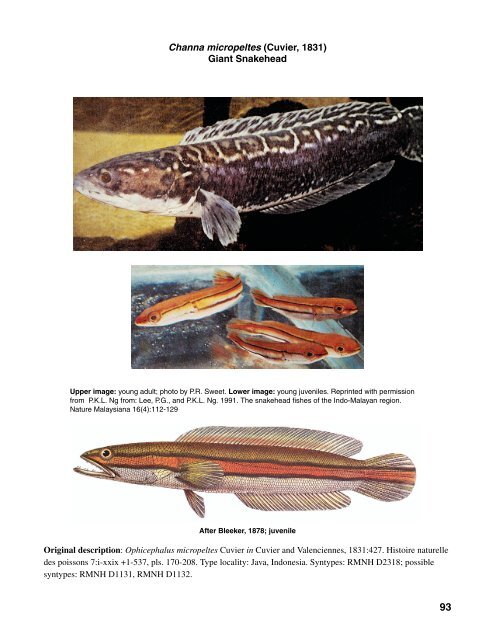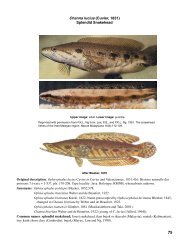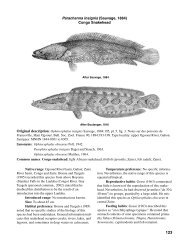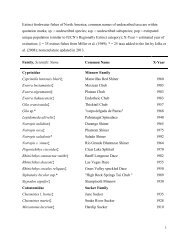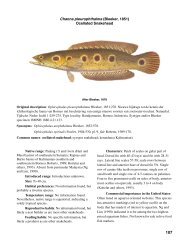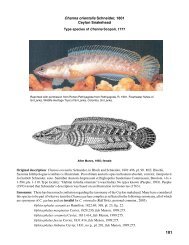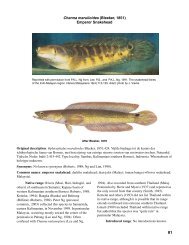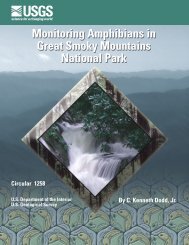Channa micropeltes (Cuvier, 1831) Giant Snakehead
Channa micropeltes (Cuvier, 1831) Giant Snakehead
Channa micropeltes (Cuvier, 1831) Giant Snakehead
Create successful ePaper yourself
Turn your PDF publications into a flip-book with our unique Google optimized e-Paper software.
<strong>Channa</strong> <strong>micropeltes</strong> (<strong>Cuvier</strong>, <strong>1831</strong>)<strong>Giant</strong> <strong>Snakehead</strong>Upper image: young adult; photo by P.R. Sweet. Lower image: young juveniles. Reprinted with permissionfrom P.K.L. Ng from: Lee, P.G., and P.K.L. Ng. 1991. The snakehead fishes of the Indo-Malayan region.Nature Malaysiana 16(4):112-129After Bleeker, 1878; juvenileOriginal description: Ophicephalus <strong>micropeltes</strong> <strong>Cuvier</strong> in <strong>Cuvier</strong> and Valenciennes, <strong>1831</strong>:427. Histoire naturelledes poissons 7:i-xxix +1-537, pls. 170-208. Type locality: Java, Indonesia. Syntypes: RMNH D2318; possiblesyntypes: RMNH D1131, RMNH D1132.93
Synonyms: Ophiocephalus serpentinus <strong>Cuvier</strong>, <strong>1831</strong>:429.Ophicephalus bivittatus Bleeker, 1845:519.Ophiocephalus stevensii Bleeker, 1853:444.Ophiocephalus diplogramma Day, 1865a:36.Ophiocephalus diplogramme [sic] Day, 1865b:147.Ophiocephalus studeri Volz, 1903:555.Common names: giant snakehead; red snakehead, redline snakehead; Malabar snakehead; Mala; ikan toman,toman (Malaysia); pla chado (Thailand), pla melang pu (Bangkok, Thailand); trey diep (juvenile) and trey chhdaur(adult; Cambodia); toman, anak toman, gabus tobang (Kalimantan). The name red or redline snakehead is commonlyapplied to juveniles of this species in the aquarium fish trade.Native range:This snakehead has a markedlydisjunctive distribution. Rivers of the Malabar(southwestern) Coast of India (restricted to KeralaState, southwestern India fide Roberts, 1989; Talwarand Jhingran, 1992); Myanmar (?); Thailand; Mekongbasin of Laos; Vietnam; Malaysia; southeasternSumatra; Kalimantan, particularly the Kapuas basin(southwestern Borneo; Roberts, 1989; Rainboth,1996); Bangka and Belitung (Billiton) islands; northernJava (Day, 1877; Mohsin and Ambak, 1983; Roberts,1989; Lee and Ng, 1991, 1994; Kottelat, 1985, 2001a).Its presence in Myanmar (Burma) is questionable.Ismail (1989) stated that it is “quite common inpeninsular Malaysia.”We found it most puzzling that a speciesdescribed from southeastern Asia (Java) could have adisjunctive distribution between a reported range insouthwestern India (Kerala State) and Thailand, itswesternmost confirmed range in southeastern Asia, adistance of about 2,500 km. Such a distribution gapindicates that the form in Kerala State, India, is either adifferent species or perhaps a very early introductionfrom its native range. We believe the latter interpretationis correct.Day (1865a) described Ophiocephalus diplogrammabased on one specimen, about 42 mm inlength, collected in October 1863 near the port city ofCochin in southwestern India. Day (1865b) provided aspecies account for O. diplogramme [sic], his entrybased on the same juvenile specimen collected in 1863near the “mouth of the Cochin River.” The charactershe provided in that original description closely matchthose of <strong>Channa</strong> <strong>micropeltes</strong>, and his description of thelife coloration appears to be that of a juvenile giantsnakehead.We believe that the description of Ophiocephalus(=<strong>Channa</strong>) diplogramma was based on a juvenileC. <strong>micropeltes</strong> and that its presence in Cochin, KeralaState, India, was the result of one or more introductionsfrom southeastern Asia that occurred prior to the mid-1800s. Cochin has been a major trading port for severalcenturies. Moving an airbreathing snakehead, even onsailing ships from its native range to a new locale some2,500 km or greater distance away, would have been aneasy task. The progeny from this introduction, resultingfrom a small founder population, would be expected toexhibit some small degree of character divergencewhen compared to the source population within itsnative range.Introduced range: This species was reportedfrom Maine, Massachusetts, and Rhode Island, withoutevidence of reproduction (Courtenay and others, 1984;Fuller and others, 1999). A review of photographs ofsnakeheads captured from open waters of Maryland,undertaken by Maryland Department of NaturalResources personnel during Summer 2002, revealedtwo specimens of giant snakeheads that had beencaught on separate occasions in different drainagesduring the two previous years. On September 6, 2002, aspecimen about 56 cm long, was found struggling nearthe surface in shallow water of the Inner Harbor, Baltimore,Maryland, and captured by dipnet. All capturesof this species appear to be of released pet fish. Twospecimens, about 46 cm in length, were confiscatedfrom an aquarium fish dealer in Los Angeles, California,in 2000 (Camm Swift, personal commun., 2002).California is one of fourteen states where snakeheadswere prohibited before summer 2002.94
Size: To 1 m and weight of over 20 kg (Roberts,1989; Lee and Ng, 1991; Talwar and Jhingran, 1992).Peter Ng (personal commun., 2003) noted that thissnakehead is known to reach a length of 1.5 m. Wee(1982) cited this species and <strong>Channa</strong> marulius as thetwo fastest growing snakeheads.Habitat preference: Lakes, rivers, canals, andreservoirs (Mohsin and Ambak, 1983; Lee and Ng,1991). Kottelat (1998) stated a preference for “deepwater bodies.” This species is nearly incapable of overlandmovements (Ng and Lim, 1990) except for theyoung (Peter Ng, personal commun., 2002), but he hasobserved large individuals attempting to move on dryland. Rainboth (1996) noted a preference for “standingor slowly flowing waters.”Temperature range: No specific information,but its native range is between 20º N to about 7º S,indicating a subtropical/tropical species.Reproductive habits: Like other channids,<strong>Channa</strong> <strong>micropeltes</strong> clear a circular area of vegetation,spawn, and the pelagic eggs rise to the surface wherethey are fiercely guarded by the parents. Guardingcontinues after hatching (Lee and Ng, 1991), probablyuntil young become demersal.Feeding habits: Primarily a daytime feeder (Ngand Lim, 1990). Accounts of this species almost invariablydescribe it as a vicious predator on other fishes.Adult and perhaps subadult <strong>Channa</strong> <strong>micropeltes</strong> feedin packs, usually in midwaters or near the surface.Parents guard their eggs and young, and are reported tohave attacked humans that approached a nest (Smith,1945; Lee and Ng, 1991). Kottelat and others (1993)stated that anglers and swimmers who got too close toyoung were attacked, some seriously wounded, andthat there have been fatalities. The report of fatalitieswas from local fisheries officials (Maurice Kottelat,personal commun., 2003). Peter Ng (personalcommun., 2002) commented that he knew of oneinstance where a man was nearly castrated by anattacking giant snakehead. Prey includes other fishes,frogs, and birds (Lee and Ng, 1994). Lee and Ng(1991) commented that authorities at the SingaporeBotanic Gardens planned to remove C. <strong>micropeltes</strong>from ponds at that facility because this snakehead wasfeeding on cygnets. Ng and Lim (1990) referred to thisspecies as the “most ravenous” of snakeheads, andthey, Mohsin and Ambak (1983), and Roberts (1989)noted that it is known to kill more fishes than itconsumes in its natural habitat. Ng and Lim (1990)described the enlarged canine teeth of C. <strong>micropeltes</strong> asbeing knifelike, “with two cutting edges in crosssection,”the edges arranged perpendicular to the bodyaxis. This allows shearing of prey.Beeckman and De Bont (1985) reported that thedigestive system of the giant snakehead is relativelyshort, that young fed on crustaceans and adults arepiscivorous in the Nam Ngum reservoir, Mekong basin,in northern Laos. They noted parasites in stomachs of60 percent of all specimens captured with even morefound in the intestines. Parasitism apparently beginswhen this species becomes piscivorous.Cowx (1998) commented that escapes ofChinese carps, tilapias, and oscar (Astronotus ocellatus)from cage culture in Chenderoh Reservoir, Perak,Malaysia, failed to establish breeding populations. Heattributed this failure to predation by giant snakeheads.Characters: A patch of scales present in thegular area. Head depressed, somewhat pointed, andflattened above. Mouth large, oblique, maxillary reachingbeyond posterior border of the eye. Lower jaw withseveral canine-like teeth behind a single row of villiformteeth, the latter expanding to about 5 rows at thejaw symphysis; large canine teeth on prevomer andpalatines. Scales on top of head small; 16-17 scale rowsbetween preopercular angle and posterior border oforbit; predorsal scales 22; 95-110 scales in longitudinalseries, although Ismail (1989) reported 82-91 for specimensfrom peninsular Malaysia. This species obviouslyhas smaller scales than other large <strong>Channa</strong>, hence thespecies name <strong>micropeltes</strong> (=small scale). Dorsal finrays 43-46; anal fin rays 27-30; pectoral rays 15; pelvicrays 6; caudal fin rounded. Pelvic fin about 50 percentof pectoral fin length (Talwar and Jhingran, 1992;Musikasinthorn and Taki, 2001).Commercial importance in the United States:This species frequently appears on aquarist-orientedwebsites. Although several sites warn that <strong>Channa</strong><strong>micropeltes</strong> is only suitable for aquarium purposes asjuveniles, require substantial amounts of animal food,and should not be kept with other fishes, it has beenavailable in aquarium fish retail stores in states wheresnakeheads are not prohibited. One retailer who sellssnakeheads via the Internet reported that he refused tosell this species to individual hobbyists (Ken Arnold,personal commun., 2002). Releases of this species intowaters of Maine, Maryland, Massachusetts, and Rhode95
Island were likely made to dispose of fish that grewtoo large for aquaria. We also know of two instances,one in 2001 and another in 2002, when juvenile giantsnakeheads were confiscated from pet shops in southernCalifornia. Because it is an esteemed food fish insoutheastern Asia, it has possibly been availableperiodically in live-food fish markets.Commercial importance in native range:Talwar and Jhingran (1992) remarked that this speciesis only of minor interest to fisheries in Kerala State,India. Conversely, Lee and Ng (1991) stated that it is ahighly prized food fish in Malaysia, and grown in cageculture where it is fed tilapia. It is also grown in cageculture in the lower Mekong basin of southern Vietnamwhere it and <strong>Channa</strong> striata collectively comprise thesecond most important fish group under culture(Pantulu, 1976; Wee, 1982). FAO (1994) listed aproduction of 1,490 metric tons of this species inThailand in 1992, up from 386 tons in 1986. Rainboth(1996) noted that it is sold fresh and sometimes aslive fish in Cambodian markets, and that it is culturedin cages.In the Kapuas River of western Kalimantan,there is a hook fishery for <strong>Channa</strong> <strong>micropeltes</strong>,particularly within the Danau Sentarum WildlifeReserve. About 40 percent of the fishes caught withlarge (sizes 5-8) hooks and 60 percent taken withmedium (sizes 9-11) hooks were giant snakehead.In recent years, cage culture has developed for thisspecies in the Reserve where large numbers ofMark Sabaj (left) purchasing specimens of giant snakehead for the Academy of Natural Sciences, Philadelphia,caught from Khao Laem Reservoir, an impoundment of Mae Nam Khwae Noi River, in a market in Thong PhaPhum, Thailand, in 2001. Photo by Mike Hardman, Los Angeles County Museum of Natural History.96
juveniles are caught with cast nets, raised in woodencages, and fed other wild caught fish until they reachmarket weight of 0.8-1.5 kg. This earns about$700,000 for the communities and represents one-thirdof fish-related income in the Reserve. Recently recognizedproblems with this activity include fear of diminishedpopulations of giant snakehead due to removal ofyoung from the wild for culture purposes and theestimated 4,000 tons of river-caught fish neededannually to feed them (Dudley, 2000).Environmental concerns: <strong>Channa</strong><strong>micropeltes</strong> has a reputation of being the mostpredacious of all snakeheads, known to kill morefishes than it consumes. Its greatest threat in the U.S.would be in southern Florida and Hawaii where thissubtropical/tropical species would likely establish ifintroduced.Comments: The diploid number of chromosomesof <strong>Channa</strong> <strong>micropeltes</strong> is 44 (Donsakul andMagtoon, 1991).See map on following page<strong>Channa</strong> <strong>micropeltes</strong>, caught by angler John Oatley; Khao Laem Reservoir, Kanchanaburi Province,Thailand, 2002. Photo courtesy of Jean-Francois Helias, Fishing Adventures Thailand.97
40°N60° E80° E100°E120°ENorthKoreaIranAfghanistanPakistanNepalBhutanChinaSouthKorea20°NSaudiArabiaIndiaMyanmarBangladeshThailandLaosVietnamThailandMalaysiaCambodia0°EquatorINDIAN OCEANIndonesiaEXPLANATIONDISTRIBUTION OF<strong>Channa</strong> <strong>micropeltes</strong>Native rangePossible native rangeIntroduced range0 1,000 MILES01,000 KILOMETERSScale is approximate<strong>Channa</strong> <strong>micropeltes</strong>98
<strong>Channa</strong> nox Zhang, Musikasinthorn, and Watanabe, 2002Night <strong>Snakehead</strong>Purchased from a live-food fish market at Mong Kok, Hong Kong. Photograph by Heok Hui Tan.Original description: <strong>Channa</strong> nox Zhang, Musikasinthorn, and Watanabe, 2002:140-146. <strong>Channa</strong> nox, a newchannid fish lacking a pelvic fin from Guangxi, China. Ichthyological Research 49(2):140-146. Type locality:Nanliu River basin, vicinity of Hepu, Guangxi Province, China. Holotype: IOZCAS (Institute of Zoology, ChineseAcademy of Sciences) 70028. Paratypes: IOZCAS 69848; IOZCAS 69849; IOZCAS 70029; IOZCAS 70039; andIOZCAS 70042.Synonyms: No synonyms.Common names: None in English. We propose night snakehead based on the dark coloration of the fish.Native range: Southern China, near Hepu,Guangzi Province, specifically the lower Nanlui JiangRiver, where its range overlaps that of its nearestcongener, <strong>Channa</strong> asiatica. Peter Ng (personalcommun., 2003) found this snakehead in live-food fishmarkets in Guangzhou, China, and Hong Kong inJuly 2000.Introduced range: No introductions known.Size: Reported to almost 20 cm (Zhang andothers, 2002), but probably attains a larger size.Habitat preference: Zhang and others (2002)reported the species from humid rainforest conditions.Appears to be a riverine species.Temperature range: No information available.Nevertheless, distribution within native range (21-32º N)indicates a warm temperate to subtropical species.Reproductive habits: No information availableconcerning reproduction in natural habitats, but likely anest builder like most snakeheads. There are indicationsthat the male of the most closely related species,<strong>Channa</strong> asiatica is perhaps a mouthbrooder. Whethersuch behavior applies to C. nox is unknown.Feeding habits: No information available, butlikely a thrust predator as is its closest relative, <strong>Channa</strong>asiatica.Characters: Gular region of head with one totwo scales on either side of underside of lower jaw.Pelvic fins absent. Head small, rounded. Dorsal fin rays47-51; anal fin rays 31-33. Lateral line scales 55-63;5.5-6.5 scales above lateral line; check scales 9-13.Total vertebrae 53-55. Large ocellus, black with whiterim, on caudal peduncle. This species is most closelyrelated to <strong>Channa</strong> asiatica which also lacks pelvic finsand has 49-53 vertebrae, 41-47 dorsal fin rays and 28-32 anal fin rays. <strong>Channa</strong> nox also differs in having ashorter predorsal length (26.9-28.4 percent) and snoutlength (3.6-5.1 percent). Live coloration also differsfrom C. asiatica in that C. nox is dark on the upper halfof the body and the ocellus on the caudal pedunclelacks a white rim.Commercial importance in the UnitedStates: None.Commercial importance in native range:Available in local markets in Hepu, Guangxi Province,southern China (Zhang and others, 2002). Alsoreported as available in markets in Ghangzhou andHong Kong (Peter Ng, personal commun., 2003).Environmental concerns: Likely a thrustpredator on other fishes and invertebrates like othersnakeheads.99
100° E120°E140°EChinaEXPLANATIONDISTRIBUTION OF<strong>Channa</strong> noxNative range20°N0°MyanmarPACIFICOCEANLaosThailandPhilippinesVietnamCambodiaMalaysiaMalaysiaINDIANOCEANIndonesiaEquator0 500 MILES0 500 KILOMETERSScale is approximateIndonesiaIndonesia<strong>Channa</strong> nox100


